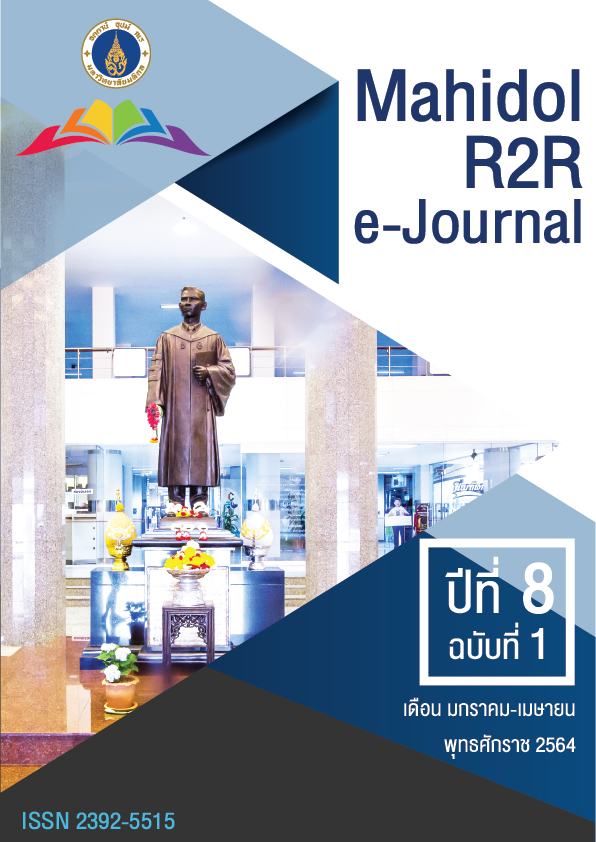การศึกษาสภาวะที่เหมาะสมต่อการผลิตอัลคาไลน์โปรตีเอสจาก alkalotolerant Bacillus sp. B12 และทำให้บริสุทธิ์บางส่วนเพื่อใช้เป็นส่วนผสมในสารซักล้างทางการค้า
DOI:
https://doi.org/10.14456/jmu.2021.4คำสำคัญ:
Alkalotolerant Bacillus sp., อัลคาไลน์โปรตีเอส, สารซักล้าง, การทำให้โปรตีเอสบริสุทธิ์บางส่วนบทคัดย่อ
จุลินทรีย์มีบทบาทสำคัญในการผลิตอัลคาไลน์โปรตีเอสทางอุตสาหกรรมโดยเฉพาะสายพันธุ์ Bacillus จากการศึกษาเบื้องต้นพบว่า alkalotolerant Bacillus sp. B12 สามารถผลิตอัลคาไลน์โปรตีเอสได้สูงสุดที่ 0.44 ยูนิตต่อมิลลิลิตร งานวิจัยนี้มีจุดประสงค์เพื่อ (1) ศึกษาสภาวะที่เหมาะสมต่อการผลิตอัลคาไลน์โปรตีเอสจาก alkalotolerant Bacillus sp. B12 ให้ได้เพิ่มสูงขึ้น และ (2) ศึกษาสภาวะที่เหมาะสมต่อการทำให้อัลคาไลน์โปรตีเอสบริสุทธิ์บางส่วนและความสามารถในการอยู่ร่วมกันได้กับสารซักล้างทางการค้า โดยทำการศึกษาอาหารและสภาวะที่เหมาะสมต่อการผลิตและการทำงานของอัลคาไลน์โปรตีเอส ประกอบด้วยการศึกษาแหล่งคาร์บอนและไนโตรเจน และปริมาณโปตัสเซียมไนเตรท ความเหมาะสมของกรด-ด่าง อุณหภูมิ ความเร็วในการเขย่า ประเมินผลผลิตจากอัลคาไลน์โปรตีเอสรวม (CP) ขณะที่การศึกษาสภาวะที่เหมาะสมต่อการทำให้อัลคาไลน์โปรตีเอสบริสุทธิ์บางส่วนและความสามารถในการอยู่ร่วมกันได้กับสารซักล้างทางการค้า ประกอบด้วยการศึกษาปริมาณเกลือแอมโมเนียมซัลเฟตอิ่มตัวที่เหมาะสมต่อการตกตะกอน CP ให้บริสุทธิ์บางส่วน ความเหมาะสมของกรด-ด่างและอุณหภูมิต่อการทำงานและเสถียรภาพของอัลคาไลน์โปรตีเอสบริสุทธิ์บางส่วน (PPP) ประเมินผลผลิตจาก PPP และความสามารถในการอยู่ร่วมกันได้กับสารซักล้างทางการค้า ทำการตรวจวัดกิจกรรมของโปรตีเอสเพื่อประเมินผลของการซักล้างต่อเสถียรภาพของ CP และ PPP
จากผลการศึกษาพบว่าอาหารและสภาวะที่เหมาะสมมากที่สุดในการผลิตอัลคาไลน์โปรตีเอสให้ได้เพิ่มสูงขึ้น เมื่อเพาะเลี้ยงในส่วนผสมกากถั่วเหลืองร้อยละ 0.5 โปตัสเซียมไนเตรทร้อยละ 0.5 พีเอช 9.0 เขย่าด้วยความเร็ว 200 รอบต่อนาที บ่มที่อุณหภูมิ 37 องศาเซลเซียส นาน 24 ชั่วโมง โดยเชื้อผลิตอัลคาไลน์โปรตีเอสได้สูงสุดที่ 0.63 ยูนิตต่อมิลลิลิตร ซึ่งเมื่อเปรียบเทียบกับการศึกษาก่อนหน้านี้จะพบว่าเชื้อผลิตอัลคาไลน์โปรตีเอสได้เพิ่มสูงขึ้นจากเดิม 1.4 เท่า สภาวะที่เหมาะสมมากที่สุดในการทำให้อัลคาไลน์โปรตีเอสบริสุทธิ์บางส่วน โดยการตกตะกอน CP ด้วยเกลือแอมโมเนียมซัลเฟตอิ่มตัวที่ร้อยละ 40-60 จะมีความบริสุทธิ์เพิ่มขึ้น 6.9 เท่า พีเอชที่เหมาะสมต่อการทำงานของ PPP อยู่ในช่วงพีเอช 8.0 ถึง 11.0 และมีเสถียรภาพต่อพีเอชในช่วง 8.0 ถึง 10.0 นาน 1 ชั่วโมง เมื่อใช้เคซีนเป็นสับสเตรท อุณหภูมิที่เหมาะสมต่อการทำงานของ PPP อยู่ในช่วง 40 ถึง 70 องศาเซลเซียส และมีเสถียรภาพสูงในช่วงอุณหภูมิ 30 ถึง 50 องศาเซลเซียส นาน 1 ชั่วโมง ขณะที่ความสามารถในการอยู่ร่วมกันได้ของโปรตีเอสกับสารซักล้างทางการค้า พบว่า PPP ทำงานได้ดีในสารซักล้างทางการค้าชนิด Baby best, Baby mild, และ Essence ตามลำดับ แต่คงทนต่อสารซักล้างชนิด St’Luke’s และ Fineline ได้น้อย ขณะที่ CP ทำงานได้ดีในสารซักล้างทางการค้าทั้ง 5 ชนิด คือ Baby best, Baby mild, Essence, St’Luke’s และ Fineline ตามลำดับ และมีเสถียรภาพดีต่อสารซักล้างชนิด Baby best ความเข้มข้นร้อยละ 1.0 ถึง 5.0 Baby mild ร้อยละ 3.0 และ Essence ร้อยละ 1.0 ดังนั้นจึงมีแนวโน้มที่จะนำ CP จาก alkalotolerant Bacillus sp. B12 ไปใช้เป็นส่วนผสมในสูตรสารซักล้างได้
เอกสารอ้างอิง
จิตธนา แจ่มเมฆ, สายสนม ประดิษฐดวง, ทะนง ภัครัชพันธุ์, ปรียา วิบูลย์เศรษฐ์, เนื้อทอง วนานุวัธ, มาลัยวรรณ อารยะสกุล, ศิวาพร ศิวเวชช, สมจิตร สุรพัฒน์, นภาศรี ไวศยะนันท์, สุคนธ์ชื่น ศรีงาม, อรอนงค์ นัยวิกุล, วรรณวิบูลย์ กาญจนกุญชร, โชคชัย ธีรกุลเกียรติ, อนุกูล วัฒนสุข, ธนะบูลย์ สัจจาอนันตกุล, วราภา มหากาญจนกุล, สิรี ชัยเสรี และปริศนา สุวรรณาภรณ์. (2540). วิทยาศาสตร์และเทคโนโลยีอาหาร. พิมพ์ครั้งที่ 2. กรุงเทพฯ : สำนักพิมพ์มหาวิทยาลัยเกษตรศาสตร์.
พิมล จำนงค์. (2546). การทำให้อัลคาไลน์โปรตีเอสจาก alkalotolerant Bacillus sp. B12 บริสุทธิ์และศึกษาสมบัติต่างๆ. (วิทยานิพนธ์ปริญญาวิทยาศาสตรมหาบัณฑิต, มหาวิทยาลัยเทคโนโลยีพระจอมเกล้าธนบุรี).
สุดารัตน์ ดุลสวัสดิ์ และ สิรอร กิจธำรงวรกุล. (2540). การผลิตเอนไซม์แอลคาไลน์โปรตีเอสจากเชื้อ Bacillus sp. ในดิน. (รายงานวิจัยปริญญาวิทยาศาสตรบัณฑิต, มหาวิทยาลัยเทคโนโลยีพระจอมเกล้าธนบุรี).
Anson, M.L. (1938). Estimation of pepsin, papain and cathepsin with hemoglobin. Journal of General Physic, 22, 79- 89.
Anwar, A. and Saleemuddin, M. (1998). Alkaline proteases: A review. Bioresource Technology, 64(3), 175-183.
Asha, B. and Palaniswamy, M. (2018). Optimization of alkaline protease production by Bacillus cereus FT 1 isolated from soil. Journal of Applied Pharmaceutical Science 80(2), 119-127.
Beg, Q.K. and Gupta, R. (2003). Purification and characterization of an oxidation-stable, thiol-dependent serine alkaline protease from Bacillus mojavensis. Enzyme and Microbial Technology, 32(2), 294-304.
Ferero, M.A., Castro, G.R., Abate, C.M., Baigori, M.D. and Sineriz, F. (1996). Thermostable alkaline protease of Bacillus licheniformis MIR29: isolation, production and characterization. Applied Microbiology and Biotechnology, 45(3), 327-332.
Gomaa, E, Z. (2013). Optimization and characterization of alkaline protease and carboxymethyl-cellulase produced by Bacillus pumillus grown on Ficus nitida wastes. Brazilian Journal of Microbiology, 44(2), 529-537.
Joo, H.S. and Chang, C.H. (2005). Production of protease from a new alkalophilic Bacillus sp. I-312 grown on soybean meal: Optimization and some properties, 40(3), 1263-1270.
Joo, H.S., Kumar, C.G., Park, G., Paik, S.R. and Chang, C.H. (2004). Bleach-resistant alkaline protease produced by a Bacillus sp. isolated from the Korean polychaete, Periserrula leucophryna. Process Biochemistry, 39(11), 1441-1447.
Joo, H.S., Kumar, C.G., Park, G.C., Kim, K.T., Paik, S.R. and Chang, C.S. (2002). Optimization of the production of an extracellular alkaline protease from Bacillus horikoshi. Process Biochemistry, 38, 155-159.
Kumar, C.G. and Takagi, H. (1999). Microbial alkaline proteases: From a bioindustrial viewpoint. Biotechnology Advances, 17(7), 561-594.
Kumar, C.G. (2002). Purification and characterization of a thermostable alkaline protease from alkalophilic Bacillus pumilus. Letters in Applied Microbiology, 34, 13-17.
Kumar, S., Ananthan, G. and Arun, J. (2015). Production, purification and characterization of alkaline protease by ascidian associated Bacillus subtilis GA CAS8 using agricultural wastes. Biocatalysis and Agricultural Biotechnology, 4, 214-220.
Lakshmi, B.K.M., Muni Kumar, D. and Hemalath, K.P.J. (2018). Purification and characterization of alkaline protease with novel properties from Bacillus cereus strain S8. Journal of Genetic Engineering and Biotechnology, 16(2), 295-304.
Sharma, M., Gat, Y., Arya, S., Kumar, V., Panghal, A. and Kumar A. (2019). A review on microbial alkaline protease: an essential tool for various industrial approaches. Journal of Industrial Biotechnology, 15(2), 69-78.
Moreira, K.A., Porto, T.S., Teixeira, M.F.S., Porto, A.L.F. and Filho, J.L. (2003). New alkaline protease from Nocardiopsis sp.: partial purification and characterization. Process Biochemistry, 39(1), 67-72.
Oskouie, S.F.G., Yakhchali, F.T.B. and Eftekhar, F. (2008). Respond surface optimization of medium composition for alkaline protease production by Bacillus clausii. Biochemical Engineering, 39(1), 37-42.
Özçelik, B., Aytar, P., Gedikli, S., Yardımcı, E., Çalışkan, F., Çabu, A. (2014). Production of an alkaline protease using Bacillus pumilus D3 without inactivation by SDS, its characterization and purification. Journal of Enzyme Inhibition and Medicinal Chemistry, 29(3), 388-396.
Patel, A.R., Mokashe, N.U., Chaudhari, D.S., Jadhav, A.G. and Patil, U.K. (2019). Production optimization and characterization of extracellular protease secreted by newly isolated Bacillus subtilis AU-2 strain obtained from Tribolium castaneum gut. Biocatalysis and Agricultural Biotechnology, 19(101122), 1-9.
Ratanakhanokchai, K., Kaneko J., Kamio Y., and Izaki K. (1992). Purification and properties of a maltotetrose- and maltotriose-producing amylase from Chloroflexus aurantiacus. Applied and Environmental Microbiology, 58(8), 2490-2494.
Rekik, H., Jaouadi, N.Z., Gargourii, F., Bejar W., Frikar, F., Jmal, N., Bejar S. and Jaouadi, B. (2019). Production, purification and biochemical characterization of a novel detergent-stable serine alkaline protease from Bacillus safensis strian RH12. International Journal of Biological Macromolecules, 121, 1227-1239.
Singh, J., Batra, N. and Sobi, R.C. (2001). Serine alkaline protease from a newly isolated Bacillus sp. SSR1. Process Biochemistry, 36(8-9), 781-785.
ดาวน์โหลด
เผยแพร่แล้ว
ฉบับ
ประเภทบทความ
สัญญาอนุญาต




